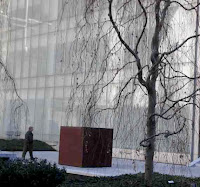 |
| Wheat Fields | ca. 1670 | Jacob van Ruisdael (Dutch) | Oil on canvas |
ART
CLOUDS
Keith Christiansen, Chairman of European Paintings at Metropolitan Museum of Art (NYC), loves to lay back and look at clouds. He also has really looked at how clouds are depicted in paintings at the museum.
 |
| Keith Christiansen |
 |
| Wheat Field with Cypresses | 1889 | Vincent van Gogh (Dutch) Oil on canvas |
 |
| View of Toledo | ca. 1597 El Greco (Domenikos Theotokopoulos) (Greek) Oil on canvas |
 |
| The Glorification of the Royal Hungarian Saints | ca. 1772 | Franz Anton Maulbertsch (Austrian) | Oil on canvas | |
 |
| Sunset Sky | ca. 1872 | John Frederick Kensett (American) Oil on canvas | |
 |
| A Mountainous Landscape with a Waterfallprobably ca. 1600 Kerstiaen de Keuninck (Flemish) | Oil on wood |
 |
| Virgin and Child with Angels | ca. 1515 | Bernard van Orley (Netherlandish) | Oil on wood | |
 |
| The Calm Sea | 1869 | Gustave Courbet (French) Oil on canvas | |
(Scource: Metropolitan Museum of Art)
FOOD
To help with your math, after a glass of wine this holiday season, here is a simplified tipping chart.
FOOD
A FUN & EXCITING DESSERT
Crepe Suzettes
 |
| Flaming the cognac for Crepe Suzettes |
Ingredients (about 6 crepes)
1 cup of flour
3/4 cup of milk
3/4 cup of water
2 to 3 whole eggs
2 tbsp. butter
1/4 tsp. of vanilla - optional
Pinch of salt
Orange Butter Sauce
1/2 cup of orange juice - fresh squeezed or carton pasteurized
Zest of 1/2 orange - optional
1/2 cup of sugar
1 stick of butter - OK to use less
airline bottle of cognac (or brandy) - about 1/4 cup
Directions for Crepes
In a large bowl mix together flour, milk, water, salt, eggs and 1 tbsp. of melted or soft butter. Whisk until well blended, about 2 minutes. Heat your medium (about 8 inches) non-stick omelet pan and coat with 1 pat of butter or oil. When butter is melted, add 1/4 cup of crepe batter - enough to just cover the bottom of the pan. Hold up pan and swirl to coat pan evenly. It is better to have too much batter than too little - a thin crepe will tear when turning. Cook crepe for a minute, then loosen around the edges and continue cooking for another minute. Peek before turning to see if crepe is starting to brown. Carefully turn crepe over and cook for another half minute. The first crepe may stick and be unusable. Don't worry, it takes a couple of crepes to get it right. The sweet Orange Butter Sauce will over compensate for problems in the appearance. Set aside your cooked crepes to add to the Orange Butter Sauce.
Directions for Orange Butter Sauce
Use a large enough pan to dip a whole crepe into. Melt butter, then add orange juice, zest and sugar into pan, over a medium/high heat. Cook until sauce is reduced by half and thickened, about 5 minutes.
Reduce heat and add a crepe. Use a spoon and fork to fold crepe into sauce. Fold in half once, then fold one more time and push crepe to the edge of the pan to make room for more. Fit about 3 crepes at a time into pan. Allow crepes to heat through for a minute.
Now the fun part - cognac flambe!
Have a long handled match ready. This is when you want an audience. Your table should be set and the lights dimmed so you can serve the flaming Crepes Suzettes with a flourish! When sauce and crepes are warm, pour in half the cognac and bring to the table. Place before your dazzled guest and strike a match, lighting the sauce. Be careful: the cognac will flame up, so you don't want flammable items too close (overhead, curtains, paper, or people). Serve this first batch of crepes with a spoonful of sauce. Finish saucing the other crepes, then flambe, and repeat.
(Source: Julia Child's Cookbook)
Until Later,
Jack
ARTSnFOOD, All rights reserved. Concept & Original Text © Copyright 2011 Jack A. Atkinson under all International intellectual property and copyright laws. Images © individual artists, fabricators, respective owners or assignees.



























































